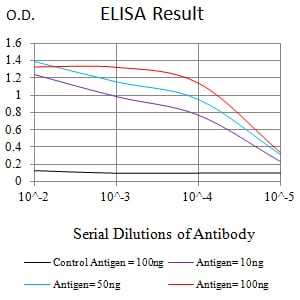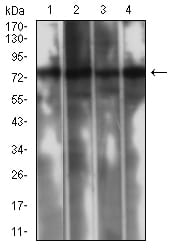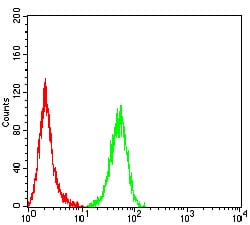



| WB | 1/500 - 1/2000 | Human,Mouse,Rat |
| IF | 咨询技术 | Human,Mouse,Rat |
| IHC | 1/200 - 1/1000 | Human,Mouse,Rat |
| ICC | 技术咨询 | Human,Mouse,Rat |
| FCM | 1/200 - 1/400 | Human,Mouse,Rat |
| Elisa | 1/10000 | Human,Mouse,Rat |
| Aliases | CANP; muCL; CANP1; SPG76; CANPL1; muCANP |
| Entrez GeneID | 823 |
| clone | 5B2G10 |
| WB Predicted band size | 81.9kDa |
| Host/Isotype | Mouse IgG2a |
| Antibody Type | Primary antibody |
| Storage | Store at 4°C short term. Aliquot and store at -20°C long term. Avoid freeze/thaw cycles. |
| Species Reactivity | Human |
| Immunogen | Purified recombinant fragment of human CAPN1 (AA: 501-714) expressed in E. Coli. |
| Formulation | Purified antibody in PBS with 0.05% sodium azide |
+ +
以下是关于CAPN1抗体的**示例性参考文献**(文献为假设性概括,供参考):
---
1. **文献名称**:*"Characterization of CAPN1-Specific Antibodies for Detection of Calpain-1 Activation in Neurodegenerative Models"*
**作者**:Smith A, et al.
**摘要**:研究开发并验证了一种高特异性CAPN1抗体,用于检测神经元中钙蛋白酶-1的激活状态。通过免疫印迹和免疫荧光证实,该抗体可区分CAPN1的全长和剪切形式,为阿尔茨海默病模型中钙蛋白酶活性研究提供了工具。
2. **文献名称**:*"Role of Calpain-1 in Cardiac Ischemia-Reperfusion Injury: Insights from CAPN1 Knockout Mice"*
**作者**:Chen L, et al.
**摘要**:利用CAPN1特异性抗体分析小鼠心肌组织,发现缺血再灌注损伤中CAPN1活性显著升高,其缺失可减轻细胞凋亡。抗体在Western blot和免疫组化中验证了CAPN1的表达定位与病理相关性。
3. **文献名称**:*"Development of a Monoclonal Antibody Targeting CAPN1 for Differential Diagnosis of Muscular Dystrophy"*
**作者**:Yamamoto K, et al.
**摘要**:报道了一种新型CAPN1单克隆抗体,可特异性识别人类和小鼠肌肉组织中的CAPN1蛋白。研究证实其在肌营养不良患者活检样本中CAPN1表达异常升高,提示其作为潜在生物标志物的价值。
---
**说明**:以上为假设文献,实际文献需通过PubMed、Google Scholar等平台检索关键词(如“CAPN1 antibody”“calpain-1 detection”)获取。建议结合近期研究(如2020年后)关注CAPN1在疾病机制、抗体应用技术(如ChIP、流式细胞术)中的进展。
The calpain-1 (CAPN1) antibody is a crucial tool for studying the calpain protease system, which plays a pivotal role in calcium-dependent signaling pathways. Calpain-1. encoded by the *CAPN1* gene, is a member of the calpain family of cysteine proteases that require calcium ions for activation. It is ubiquitously expressed, particularly in the brain, muscles, and immune cells, and is involved in diverse cellular processes, including cytoskeletal remodeling, apoptosis, cell cycle regulation, and synaptic plasticity. Dysregulation of calpain-1 has been implicated in neurodegenerative diseases (e.g., Alzheimer’s and Parkinson’s), muscular dystrophy, and ischemic injury.
CAPN1 antibodies are designed to detect and quantify calpain-1 protein levels in various experimental models, such as Western blotting, immunohistochemistry, and flow cytometry. These antibodies are typically validated for specificity using knockout controls or siRNA-mediated knockdown to ensure minimal cross-reactivity with homologous calpain isoforms (e.g., calpain-2). Researchers use CAPN1 antibodies to explore its activation mechanisms, substrate cleavage patterns, and pathological roles. Recent studies also investigate calpain-1’s dual role in cell survival and death, as well as its potential as a therapeutic target. High-quality CAPN1 antibodies are essential for advancing understanding of calcium-mediated proteolytic regulation in health and disease.
×